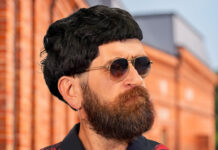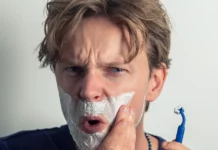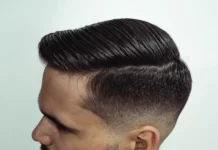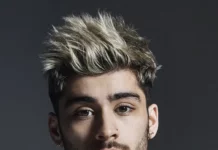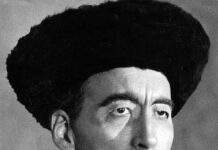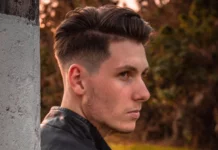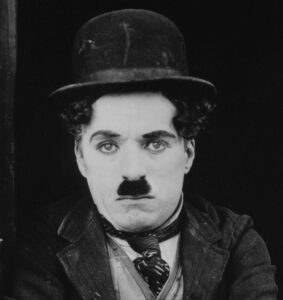 The toothbrush mustache, once a popular style, has been controversial for a long time due to its association with Hitler. Despite this, it remains an iconic part of early 20th-century culture, thanks in large part to the influence of Charlie Chaplin and Oliver Hardy. In fact, it was a staple of World War I propaganda posters and political cartoons, representing stateside patriotism and wartime virility.
The toothbrush mustache, once a popular style, has been controversial for a long time due to its association with Hitler. Despite this, it remains an iconic part of early 20th-century culture, thanks in large part to the influence of Charlie Chaplin and Oliver Hardy. In fact, it was a staple of World War I propaganda posters and political cartoons, representing stateside patriotism and wartime virility.
The toothbrush mustache is recognized for being Hitler’s mustache, and as such, its use declined after the Second World War. However, its roots date back to the end of the 19th century in Germany, when it gained popularity thanks to Americans tourism.
If you’re interested in wearing the toothbrush mustache, it’s important to be aware of its cultural sensitivity. By understanding its history and significance, you can make an informed decision about whether or not it’s appropriate for you to wear this style. Let’s explore the toothbrush mustache further and learn how to make the most of this unique and controversial style.
Origins and Evolution of the Toothbrush Mustache
The toothbrush initially gained popularity thanks to the influence of Charlie Chaplin and Oliver Hardy. Chaplin, known for his iconic portrayal of “The Tramp”, made the toothbrush mustache an essential part of his character’s look. His popularity helped to establish the mustache as a symbol of comedy and humor, making it a popular style among other comedians of the time.
Oliver Hardy, the other half of the famous comedy duo Laurel and Hardy, also sported the toothbrush mustache, further cementing its place in popular culture. However, the mustache’s association with Adolf Hitler and the Nazi Party played a significant role in its decline in popularity.
Hitler’s aggressive expansionist policies and leadership role in the Nazi Party created strong opposition to Nazism, which was only further solidified by the horrific consequences of World War II and the atrocities of the Holocaust. As a result, the toothbrush mustache is no longer a popular style, and wearing it can send a message that is associated with the destructive ideology of Nazism.
Contrary to popular belief it is not illegal to wear a toothbrush mustache in Germany (or anywhere else), its association with Hitler means that it is not often seen as an appropriate style to wear. It is important to be aware of its cultural sensitivity and to understand the historical context behind this controversial mustache style.
Notable Attempts at Reclaiming the Toothbrush Mustache
Despite its cultural sensitivity, there have been notable attempts at reclaiming the toothbrush mustache in popular culture. In 2009, comedian Richard Herring used the controversial Hitler mustache for one of his shows in Edinburgh, but it did not go down well with the audience. Herring faced a lot of backlash for his decision to use the mustache and later admitted that it was something he could have easily avoided.
On the other hand, Michael Jordan, the famous basketball player, used his fame to model advertising for hundreds of products. In one of his ads for the Hanes brand, Jordan sported a toothbrush mustache. However, many speculate that he did it as a tribute to Charlie Chaplin rather than as a deliberate attempt to reclaim the toothbrush mustache.
Despite these attempts, this mustache style remains a controversial style due to its association with Hitler and Nazism.
The Societal Stigma and Challenges of Wearing a Toothbrush Mustache Today
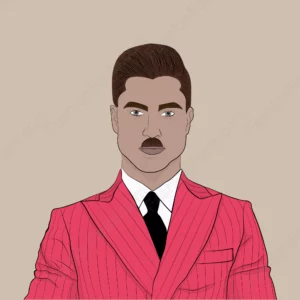 While this style was popular in the past, it became stigmatized due to its association with Hitler, who was responsible for some of the worst atrocities in human history. In fact, some people even refer to this style of mustache as a “Hitler mustache”, further adding stigma to those who seek to reclaim this facial hair style.
While this style was popular in the past, it became stigmatized due to its association with Hitler, who was responsible for some of the worst atrocities in human history. In fact, some people even refer to this style of mustache as a “Hitler mustache”, further adding stigma to those who seek to reclaim this facial hair style.
Those who do wear the toothbrush mustache may be perceived as insensitive or even sympathetic to Nazi ideology, causing backlash or misunderstandings that could have easily been avoided by choosing another style.
In addition, the toothbrush mustache is not a common style today, so wearing it may make an individual stand out in an undesirable way. It could be seen as an attempt to be provocative or to draw attention to oneself, which could result in negative reactions from others. It is important to consider the societal stigma associated with the toothbrush mustache before deciding to wear it.
In terms of social acceptability, the toothbrush mustache is generally considered taboo in Germany and much of the western world. The mustache style has not been widely popular since the end of World War II, and many people still associate it with the atrocities committed during that time. Therefore, it is not socially acceptable to wear such a mustache in Germany, and it may even offend some people.
Alternative Mustache Styles to Consider
If you are hesitant to wear the toothbrush mustache due to its negative connotations, there are many alternative mustache styles to consider that are popular and stylish. Here are a few options:
The Chevron
The Chevron mustache is a thick mustache that covers the top lip and extends down to the corners of the mouth without connecting to the beard or sideburns. It’s a classic style that has been worn by many celebrities, including Tom Selleck, Ron Swanson from the TV show Parks and Recreation, and Hulk Hogan.
The Handlebar
The handlebar mustache style extends past the edges of the mouth and can be styled up or down. It requires some maintenance to keep it looking neat, but it gives off a classic and sophisticated look. Some well-known figures who have sported this style Rollie Fingers, and Daniel Day-Lewis.
The Pencil
The pencil mustache is a thin & narrow mustache that is groomed to a fine point at the center of the upper lip. It’s a subtle and understated style that works well for those who want a more minimalist look. Some well-known figures who have sported this style include Clark Gable, John Waters, and Brad Pitt.
The Horseshoe Mustache
The horseshoe mustache extends down from the top lip and curls downward at the corners of the mouth, resembling a horseshoe. It’s often associated with a tough-guy biker or wrestler look. Some well-known figures who have sported this style include Hulk Hogan, Lemmy Kilmister from the band Motorhead, and Samuel L. Jackson in the movie “Pulp Fiction.”
The benefits of these alternative mustache styles are that they allow you to wear a stylish mustache without any negative connotations or societal stigma. Plus, if you don’t like the way it looks, you can simply shave it off and try a new style. By choosing one of these alternative styles instead of the toothbrush mustache, you can avoid any potential misunderstandings or negative reactions.
Conclusion
In conclusion, the toothbrush mustache is a controversial style that has a rich history dating back to the early 20th century. While it was popularized by comedic icons such as Charlie Chaplin and Oliver Hardy, its association with Adolf Hitler and Nazism has made it a potentially offensive and culturally sensitive style. While notable attempts have been made to reclaim the toothbrush mustache in popular culture, its societal stigma and potential for negative reactions make it a style that many should consider avoiding.
Fortunately, there are many alternative mustache styles available, such as the Chevron, Handlebar, Pencil, and Horseshoe, that offer stylish options without the negative connotations.
By being aware of the historical and cultural context of different mustache styles, individuals can make informed decisions and avoid any potential misunderstandings.

